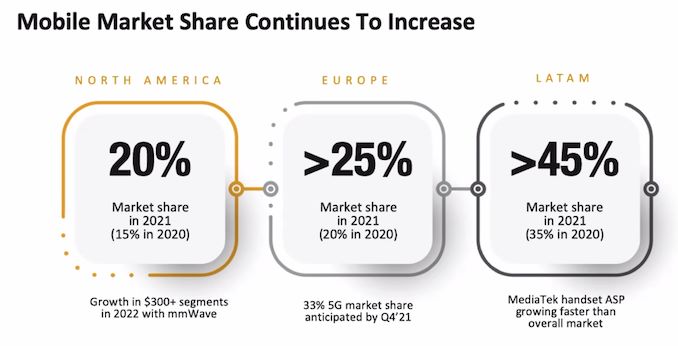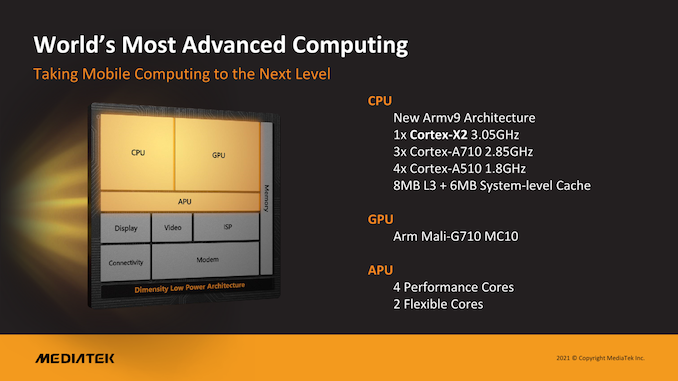MediaTek Announces Dimensity 9000: Supercharged Flagship SoC on 4nm
by Andrei Frumusanu on November 18, 2021 6:00 PM ESTConclusion & First Impressions
MediaTek’s re-entry in the flagship SoC space with the Dimensity 9000 comes at quite the opportunistic time in the landscape. The company has had a very successful 2021 with large market share gains, and we’ve even seen this translate into more exposure in more visible design wins in the market, such as the OnePlus Nord 2 series or the Xiaomi 11T.
Having seen large market share gains and being able to fill in a huge gap in the market where Huawei and HiSilicon were in the past, the Dimensity 9000 seems to have come at the perfect time, as more vendors want to be able to differentiate their highest end devices and diversify their reliance on Qualcomm’s Snapdragon series.
The Dimensity 9000, on paper, and by the specification, looks like an extremely strong SoC for 2022 flagships. On the CPU side of things, MediaTek has fully equipped the SoC with near the maximum possible configuration – high frequencies, large caches, and surprisingly enough for us today, a full performance configuration of the new Cortex-A510 cores. The 8MB L3 is helped by a new 6MB system cache that further improves memory performance, which the Dimensity 9000 of is currently the first and only chip to support new LPDDR5X.
The GPU side, the chip likely will be the only design for 2022 with a large Mali GPU. Advertised performance figures are good, but what matters most is power efficiency and sustained performance. While the metrics here are still a bit vague, the N4 process node of the chip, again, the first of its kind, is likely to position the chip in an excellently against 2021 devices, and if Qualcomm and Samsung don’t have major leaps in their upcoming designs, also position the Dimensity 9000 extremely well against the 2022 competition.
MediaTek’s camera and ISP leaps are also just huge. We haven’t really had many camera-centric phones powered by MediaTek silicon over the last few years, so if vendors are able to take advantage of the chip’s new camera architecture remains to be seen, but at least the high-level specifications are definitely worthy of 2022 flagships.
The chip’s lack of mmWave is likely limit its success to non-US markets and devices, but that’s a situation we generally become used to over the years.
The Dimensity 9000 is MediaTek’s strongest showing in years, and has the specifications and heft to properly shake up the high-end market. I see it competing against, or even besting whatever Qualcomm has in queue for next year, which is a pretty shocking turn of events. What matters now, is for MediaTek to actually have the high-profile flagship device design wins, to be able to fully rationalise their investment in such a SoC. Luckily, we’ve been told the chip has already sampled to customers, and we’re to expect commercial device launches in the first quarter of 2022. Exciting times are ahead in the mobile SoC space.












150 Comments
View All Comments
syxbit - Thursday, November 18, 2021 - link
>>The GPU side, the chip likely will be the only design for 2022 with a large Mali GPUSurely the Tensor 2 will be another large Mali ?
arayoflight - Friday, November 19, 2021 - link
Pretty sure Google will use the AMD IP from S.LSI for Tensor 2.dotjaz - Friday, November 19, 2021 - link
Surely you know Google will use whatever Samsung is using.UNLK A6 - Thursday, November 18, 2021 - link
Mediatek slide decks are always a laugh. "World's first", "World's best." But please AnandTech don't publish their bogus slides without getting out your sharpie. Almost every "graph" is visually exaggerated. For example the first graph labeled +35% actually has a bar chart with 54% increase in height. Make fun of their charts and try to keep them honest.Tomatotech - Saturday, November 20, 2021 - link
You made me go back and actually count the pixels in the first two graphs. The bar charts are proportionally the correct heights for the numbers they represent. You've just wasted 5 minutes of my time and made yourself look a fool. Next time check your facts before making wild claims.Thanks for actually making MediaTek look more honest, which probably wasn't your aim.
mode_13h - Sunday, November 21, 2021 - link
> You've just wasted 5 minutes of my timeThanks for that. I was inclined to believe the previous poster.
UNLK A6 - Sunday, November 21, 2021 - link
See my comments below for clarity on who to believe.UNLK A6 - Sunday, November 21, 2021 - link
Well, perhaps you should check again. Not only is it obvious that the first bar is not a 35% lift from the second as claimed on the slide, if you count pixels you'll find it's a 54% lift.Perhaps you (like the chart maker) misunderstand that a 35% lift is not the same as a 35% drop. In this case the reciprocal of 1.54 is 0.65. The chart is simply wrong because either the chart maker is clueless or they are being deliberately misleading. A 35% lift is the same as a 26% drop. Clearly not what is depicted.
I tend to lean on deliberately misleading because MediaTek does this year after year.
mode_13h - Monday, November 22, 2021 - link
Thanks for the follow-up.Wilco1 - Tuesday, November 23, 2021 - link
You are wrong, the graph is correct - the first bar has 135% of the height of the 2nd bar, so it correctly shows the 35% performance uplift. I suggest you count the pixels rather than making things up.